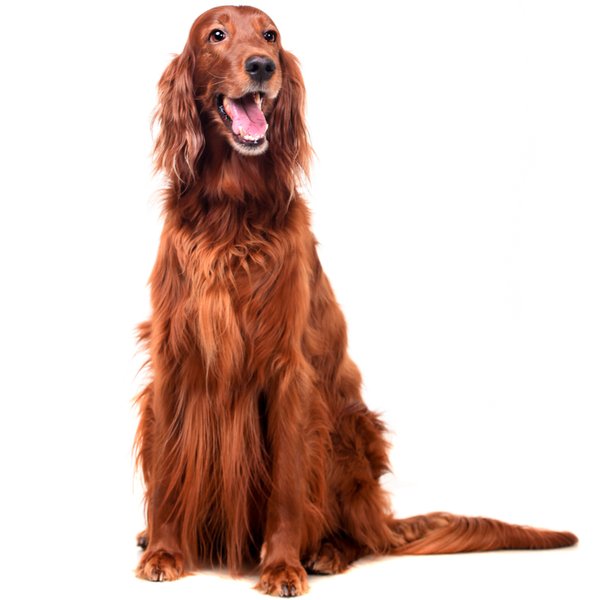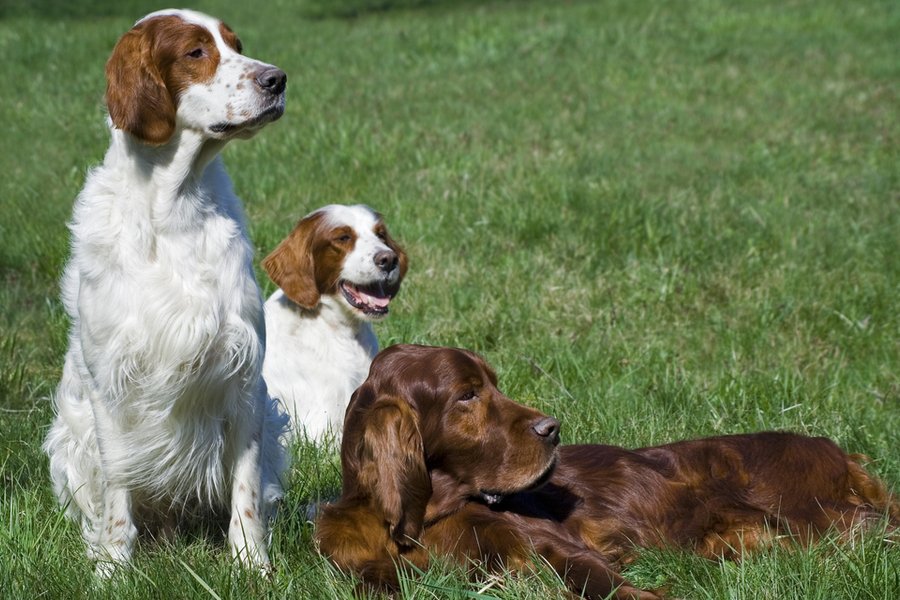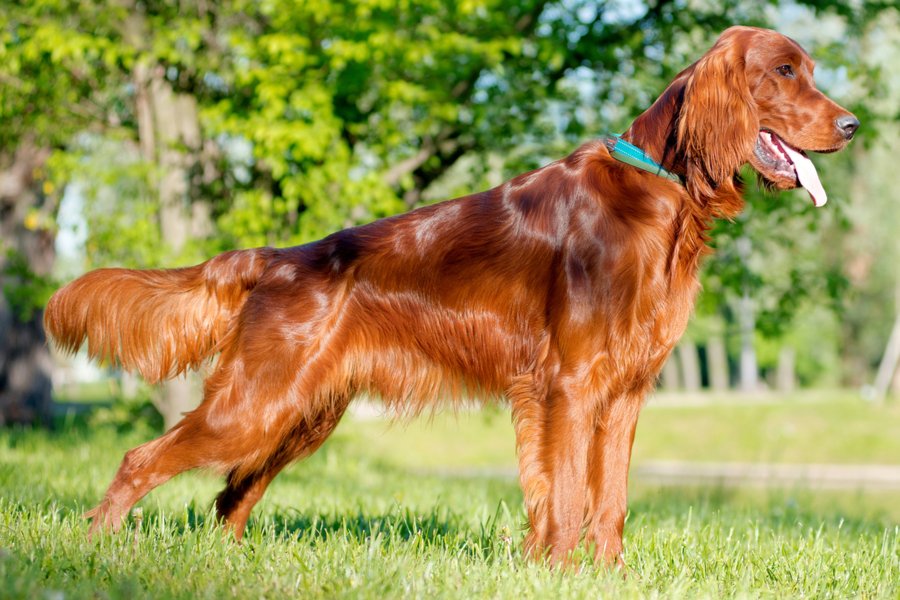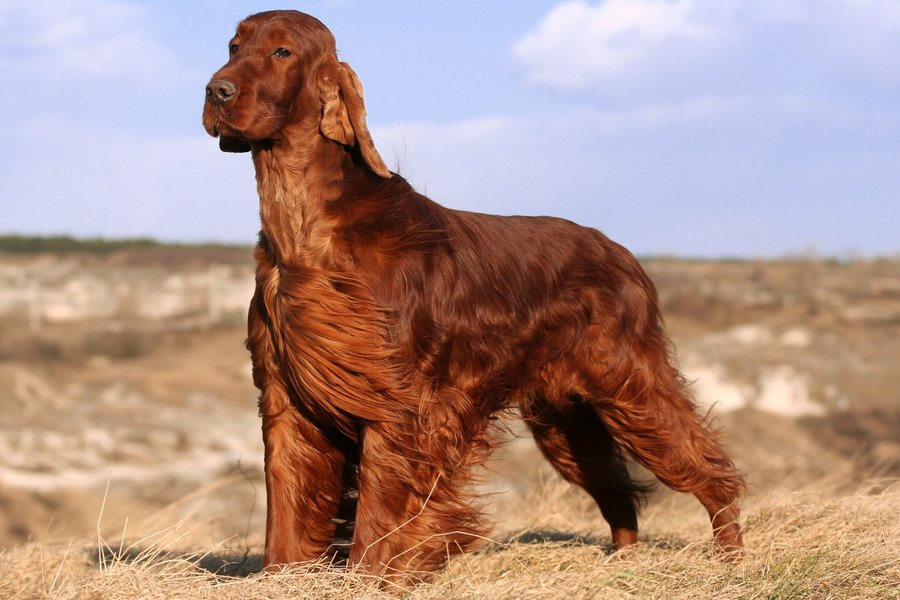Average sizes and life expectancy for this breed:
Irish Setters are large gundogs that originated in Ireland. Known as the “Red Setter” because of their glamorous bright coats, these dogs differed from the two other Irish breeds; the Red and White Setter, and the Hail Setter which is now believed to be extinct. Selected breeding programs gave Irish Setters a long, refined head and much lighter boning than their other Irish cousins.
One of the first things you will notice when you come across this dog breed is their impressive silky and shiny coat of chestnut or red. Beautiful feathering adorns the upper portion of the ears, on the back of the front and back legs, and the abdomen, forming a fringe that extends to the throat and chest. Their feet are also feathered between the toes and the tail has moderately long fur that decreases in length towards the tip. Their long legs and powerful rear drive have made Irish Setters among the fastest of all sporting dogs
Irish Setters have a delightful character that has endeared them to pet owners and sportsmen for more than two hundred years. They are extrovert dogs who adore making new friends – they are just big kids at heart. These dogs are also eager to please and will respond to positive patient training. Irish Setters are said to be courageous and tough hunting partners.
However, they are not just graceful hunters, Irish Setters are also exceptionally affectionate which has made them popular therapy dogs. Irish Setters are incredibly active so they will do best in country homes where someone is around for most of the day.
See available puppies




This dog breed is thought to be the youngest of the three Setter breeds, possibly descended from the English Setter and the Gordon Setter. They were specifically bred to be efficient working dogs that could sniff out birds in the 1800s. The dog would then set down on the floor to indicate to the hunter that prey had been found. Once the bird had been flushed out of hiding, the hunter would shoot it and the Setter would retrieve the game. Their eye-catching colour also made these dogs very easy to spot by their owners in thick cover.
The earliest ancestors of the Irish Setter we know today were red and white but then a "landmark" dog came along that changed the perception of these dogs. Champion Palmerston was an outstanding, lighter-boned, red-mahogany dog who came on the scene in 1862. He caused such a stir that most of our modern-day Irish Setters can trace their lineage right back to him. These dogs have remained big players in the dog show ring since the sport first appeared in the 1870s.
Furthermore, despite not arriving on the canine scene until the 19th Century, Irish Setters became one of the first nine breeds to gain early recognition by the American Kennel Club in 1878. The Irish Setter Breeders Club in the UK was founded in 1938.
Today, Irish Setters are beloved family canine companions and occasionally hunting dogs. The dog breed has also enjoyed fame and popularity because they inspired the Walt Disney movie and the books about "Big Red” written by Jim Kjelgaard in 1945.


Irish Setters have a very athletic and sleek appearance with an incredible amount of power in their hind legs. These glamorous-looking dogs are working canines who love nothing more than having a job to do. They boast long, lean heads that are somewhat domed in between their well-feathered ears. Their square muzzles are quite long and deep with strong jaws and wide nostrils. The nose is either dark walnut, black, or dark mahogany in colour.
These dogs have almond-shaped eyes that are dark hazel to dark brown in colour. They are set level under their brows and express an intelligent and kind look. Their medium-sized ears are fine in texture and set low and well back. They hang neatly on the head, showcasing a neat fold.
Irish Setters have moderately long, well-muscled necks that are slightly arched. Their shoulders are deep and sloping with muscular and straight front legs. The chest is deep and quite narrow when viewed from the front. They also have well-sprung ribs that are carried well back. Their muscular loins are slightly arched, adding an elegant appeal to their overall appearance. An Irish Setter’s topline moderately slopes away from the withers and their powerful hind legs are broad. Their small feet are firm with strong, arched, and closed toes. Their long tails are set just below the level of the back. They tend to be much thicker at the root and become thinner toward the tip.
Irish Setters boast a long, silky coat that is free of curls. Their ears, the back of the fore and hind legs, and their undersides are well-feathered. Their feet are also well-feathered in between their toes, and their tails have a fringe of long hair right to the tip. Perhaps the most noteworthy physical trait of this breed is their gorgeous rich chestnut coloured coat. These dogs can have a modest amount of white on their chin, throat, chest, and toes under the UK breed standard. A small star on the forehead or a narrow streak on the nose is also accepted.
Originally bred to be gundogs, Irish Setters are lively and affectionate. They enjoy being with their families and love to participate in all the fun and games that happen in the household. They consistently exhibit a fun-loving, eager to please, and always excited personality, which makes them an excellent choice for active owners and families.
Known to be high energy dogs, Irish Setters must be given ample time and attention to thrive, including around two hours of moderate-intense exercise daily. If these dogs become bored, they can get themselves into all sorts of trouble. They also have a reputation for being big barkers if they are bored. To avoid this, make sure you keep their minds and bodies stimulated with plenty of enrichment.
Irish Setters form very deep bonds with their family members so they should not be left alone for long periods. They are also known to be a little accident-prone due to their quick maneuverability and speedy run.
With their loving and friendly natures, Irish Setters are an excellent choice for families. However, these highly energetic dogs may not be the best choice for families with young kids or toddlers. Irish Setters can be a bit too energetic and boisterous when they interact and play, which can lead to injury if they are not supervised around little children.


The Irish Setter is a happy, affectionate, and keen to please dog breed. Keep training methods constant but make sure sessions remain fun and interesting to prevent boredom. They respond best to positive, reward-based training methods. Breeders and veterinarians recommend early socialisation and training classes for these dogs to ensure they grow up into well-mannered adults. Irish Setters are highly intelligent however, they are also naturally stubborn and independent. So, they must understand what is expected of them from a young age.
Furthermore, Irish Setters shine in dog sports such as agility, hunting, rally, flyball, dock diving, and tracking. Their sensitive characters make them excellent therapy and assistance dogs. It’s worth bearing in mind that recall and lead training are essential for this breed because they can dash off without a moment's notice if they pick up an enticing scent.
The Irish Setter’s gorgeous rich-red coat requires moderate grooming to look its best. This dog breed must be brushed at least 3-4 times a week using a pin brush or a soft bristle brush. A long-toothed metal dog comb can also be used to remove any tangles or mats.
Their nails must be trimmed once a month or so if they don’t get worn down naturally. An occasional bath with a vet-approved gentle shampoo for dogs will also help to keep their coat and skin clean and healthy. Grooming sessions are a good time to do an overall check for any new bumps or skin problems and to check if their eyes and ears are healthy and free of infections.
Clean their ears regularly with a damp, warm cloth, and run a cotton swab around the edges of the ear canal. Never stick the cotton swab directly into the ear as this can cause damage. If the borders of their ears are dry, you can apply a small amount of mineral or baby oil.
Your dog’s teeth must be brushed at least two or three times a week to prevent tartar and bacteria buildup. Preferably, daily brushing is best to avoid tooth and gum disease and bad breath.
Lastly, inspect your dog’s body parts for rashes, wounds, sores, or any trace of infection such as inflammation on their eyes, nose, mouth, ears, skin and feet, or any soreness and redness.


Irish Setters are generally healthy dogs. Their life expectancy is between 12-14 years with proper care, exercise, and a high-quality diet. However, like other dog breeds, Irish Setters can develop health conditions as they mature and grow. Always purchase an Irish Setter puppy from a licensed breeder to ensure they have been well taken care of. They will also test your puppy for any underlying health conditions.
Here are some of the more common health issues seen in Irish Setters:
Irish Setters are good canine companions for active older children. However, they can be too energetic for toddlers. They can easily injure a young child, so it is not advisable to leave an Irish Setter alone with a young child.
This dog breed is also good with other dogs in the household and cats, especially if they are socialised from an early age. But remember to keep an eye on pet birds as these dogs might see them as prey. You should introduce new pets gradually in a controlled environment to increase the likelihood of them getting along.


We can connect you with Breeders that are specialized in this particular breed.
See available puppies

Need some advice?
Whether you're a first time pet owner, an experienced pet owner, a new or long-time breeder, or just curious about pets, we've got you covered!

January 17, 2024
What Is The Personality Of Russian Blue Cats?
Russian Blue cats are most known for their distinctive shimmery blue-silver coat and piercing green eyes. However, this breed’s calm and gentle temperament is what makes them shine the most in the feline world.

January 17, 2024
10 Facts About Russian Blue Cat Breed
Russian Blues are one of the most aesthetically stunning cat breeds, with a gorgeous plush silvery coat and vibrant green eyes. However, it’s not only their appearance that is beautiful; their nature is too.

January 17, 2024
How To Choose The Right Cat Breed for You
Cats can make the most fantastic animal companions; they are adorable, friendly, and loving. However, not all felines are created equal. There are many different breeds, of which each has its unique personality traits.
Need some help?
Contact us to speak to our friendly advisor, who will gladly help you find your dream pet!



We are registered in England and Wales under registration number 12568840,
and our registered office is at 58-60 Kensington Church Street, W8 4DB London, England.
© 2023 The Pedigree Paws